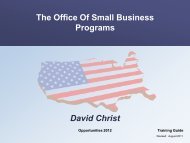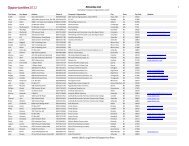Capital Opportunities for Small Businesses - sbtdc
Capital Opportunities for Small Businesses - sbtdc
Capital Opportunities for Small Businesses - sbtdc
Create successful ePaper yourself
Turn your PDF publications into a flip-book with our unique Google optimized e-Paper software.
C A P I T A L O P P O R T U N I T I E S F O R SMA L L B U S I N E S S E S<br />
businesses, continues to revolve loaned funds (interest and principal), and does not have a termination<br />
date.<br />
As of April 2011, the RLF program encompassed 575 RLFs, with a combined capital base of $862<br />
million, which represents a 4% increase in the capital base over September 2010. The majority of these<br />
RLFs reported concentrating on making loans in the range of $25,000 to $175,000, although a number<br />
of RLF operators made much smaller (as little as $1,000) or much larger ($1 million+) loans.<br />
Public Works and Economic Development Assistance<br />
EDA’s Public Works and Economic Development Program help distressed communities revitalize,<br />
expand, and upgrade their physical infrastructure. This program enables communities to attract new<br />
industry; encourage business expansion; diversify local economies; and generate or retain long-term,<br />
private sector jobs and investment through the acquisition or development of land and infrastructure<br />
improvements needed <strong>for</strong> the successful establishment or expansion of industrial or commercial<br />
enterprises.<br />
Public Works investments help facilitate the transition of communities from being distressed to<br />
becoming competitive in the worldwide economy by developing key public infrastructure, such as<br />
technology-based facilities that utilize distance learning networks, smart rooms, and smart buildings;<br />
multi-tenant manufacturing and other facilities; business and industrial parks with fiber optic cable;<br />
and telecommunications and development facilities. EDA continues to invest in its traditional Public<br />
Works projects, including water and sewer systems improvements, industrial parks, business incubator<br />
facilities, expansion of port and harbor facilities, skill-training facilities, and brownfields redevelopment<br />
Economic Adjustment Assistance<br />
The Economic Adjustment Assistance (EAA) program uses a flexible set of tools to respond to the wide<br />
range of economic development challenges in communities and regions across the nation, including<br />
globalization, natural resource depletion, corporate restructuring, and natural disasters. EAA is the<br />
most effective single program in EDA’s arsenal to address areas impacted by globalization, especially<br />
manufacturing dependent communities that need to develop and implement regional strategies that<br />
will trans<strong>for</strong>m and diversify their economies and position them competitively in the global marketplace.<br />
EAA funds can be used to design the transition strategy, construct or upgrade public infrastructure, and<br />
capitalize locally or regionally administered Revolving Loan Funds that directly assist innovative<br />
entrepreneurs in growing 21st century businesses. Additionally, the EAA program, with its <strong>for</strong>wardlooking<br />
imminent threat authority, allows EDA to initiate interventions be<strong>for</strong>e a community’s economy<br />
bottoms out, when economic trends may clearly indicate the need <strong>for</strong> intervention but the trailing<br />
economic eligibility indicators employed in other programs may not provide adequate access to other<br />
assistance.<br />
Economic Development Planning Assistance<br />
The Economic Development Planning Assistance program provides essential investment support to<br />
District Organizations, Native American organizations, states, sub-state planning regions, urban<br />
counties, cities and other eligible recipient to assist in planning. The two categories of the Planning<br />
Assistance program are: (a) Planning investments <strong>for</strong> District Organizations, Indian Tribes and other<br />
eligible entities; and (b) Short-Term Planning investments to states, sub-state planning regions and<br />
53









